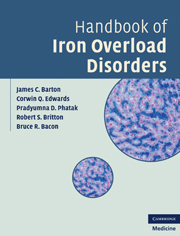Book contents
- Frontmatter
- Contents
- Foreword by Anthony S. Tavill
- Preface
- 1 History of iron overload disorders
- 2 Normal iron absorption and metabolism
- 3 Iron toxicity
- 4 Tests for hemochromatosis and iron overload
- 5 Complications of hemochromatosis and iron overload
- 6 Insulin resistance and iron overload
- 7 Infections and immunity
- 8 Classical and atypical HFE hemochromatosis
- 9 Heterozygosity for HFE C282Y
- 10 Porphyria cutanea tarda
- 11 Mitochondrial mutations as modifiers of hemochromatosis
- 12 Hemochromatosis associated with ferroportin gene (SLC40A1) mutations
- 13 Hemochromatosis associated with hemojuvelin gene (HJV) mutations
- 14 Hemochromatosis associated with hepcidin gene (HAMP) mutations
- 15 Hemochromatosis associated with transferrin receptor-2 gene (TFR2) mutations
- 16 Iron overload associated with IRE mutation of ferritin heavy-chain gene (FTH1)
- 17 Hereditary hyperferritinemia-cataract syndrome: IRE mutations of ferritin light-chain gene (FTL)
- 18 Iron overload in Native Africans and African-Americans
- 19 Hereditary atransferrinemia
- 20 Divalent metal transporter-1 (SLC11A2) iron overload
- 21 Iron overload associated with thalassemia syndromes
- 22 Iron overload associated with hemoglobinopathies
- 23 Iron overload associated with pyruvate kinase deficiency
- 24 Iron overload associated with congenital dyserythropoietic anemias
- 25 Hereditary sideroblastic anemias
- 26 Pearson marrow–pancreas syndrome
- 27 Acquired sideroblastic anemias
- 28 Hereditary aceruloplasminemia
- 29 Friedreich ataxia and cardiomyopathy
- 30 Pantothenate kinase (PANK2)-associated neurodegeneration
- 31 Neuroferritinopathies
- 32 GRACILE syndrome
- 33 Neonatal hemochromatosis
- 34 Iron overload due to excessive supplementation
- 35 Localized iron overload
- 36 Management of iron overload
- 37 Population screening for hemochromatosis
- 38 Ethical, legal, and social implications
- 39 Directions for future research
- Index
- Plate section
- References
14 - Hemochromatosis associated with hepcidin gene (HAMP) mutations
Published online by Cambridge University Press: 01 June 2011
- Frontmatter
- Contents
- Foreword by Anthony S. Tavill
- Preface
- 1 History of iron overload disorders
- 2 Normal iron absorption and metabolism
- 3 Iron toxicity
- 4 Tests for hemochromatosis and iron overload
- 5 Complications of hemochromatosis and iron overload
- 6 Insulin resistance and iron overload
- 7 Infections and immunity
- 8 Classical and atypical HFE hemochromatosis
- 9 Heterozygosity for HFE C282Y
- 10 Porphyria cutanea tarda
- 11 Mitochondrial mutations as modifiers of hemochromatosis
- 12 Hemochromatosis associated with ferroportin gene (SLC40A1) mutations
- 13 Hemochromatosis associated with hemojuvelin gene (HJV) mutations
- 14 Hemochromatosis associated with hepcidin gene (HAMP) mutations
- 15 Hemochromatosis associated with transferrin receptor-2 gene (TFR2) mutations
- 16 Iron overload associated with IRE mutation of ferritin heavy-chain gene (FTH1)
- 17 Hereditary hyperferritinemia-cataract syndrome: IRE mutations of ferritin light-chain gene (FTL)
- 18 Iron overload in Native Africans and African-Americans
- 19 Hereditary atransferrinemia
- 20 Divalent metal transporter-1 (SLC11A2) iron overload
- 21 Iron overload associated with thalassemia syndromes
- 22 Iron overload associated with hemoglobinopathies
- 23 Iron overload associated with pyruvate kinase deficiency
- 24 Iron overload associated with congenital dyserythropoietic anemias
- 25 Hereditary sideroblastic anemias
- 26 Pearson marrow–pancreas syndrome
- 27 Acquired sideroblastic anemias
- 28 Hereditary aceruloplasminemia
- 29 Friedreich ataxia and cardiomyopathy
- 30 Pantothenate kinase (PANK2)-associated neurodegeneration
- 31 Neuroferritinopathies
- 32 GRACILE syndrome
- 33 Neonatal hemochromatosis
- 34 Iron overload due to excessive supplementation
- 35 Localized iron overload
- 36 Management of iron overload
- 37 Population screening for hemochromatosis
- 38 Ethical, legal, and social implications
- 39 Directions for future research
- Index
- Plate section
- References
Summary
Hepcidin, an antimicrobial peptide produced by hepatocytes, is a central negative regulator of iron absorption that is encoded by the HAMP gene on chromosome 19q13 (Chapter 2). In humans, HAMP mutations account for a rare subtype of juvenile-onset hemochromatosis (OMIM #602390). Some patients have an autosomal recessive disorder associated with homozygosity for rare pathogenic HAMP mutations. Others have hemochromatosis phenotypes due to heterozygosity for a pathogenic HAMP mutation and co-inheritance of heterozygosity or homozygosity for HFE C282Y.
The precursor of hepcidin comprises 84 amino acids, from which 3 active peptides of 25, 22, and 20 amino acids, respectively, are produced by protease cleavage. The 25 and 20 amino acid peptides represent the major forms. Active forms of hepcidin contain numerous cysteines. Eight highly-conserved cysteine residues form four disulfide bonds, the critical basis of a rigid structure of the final peptide. The HAMP promoter contains consensus sequences for the transcription factor CCAAT/enhancer binding protein-α (CEBP/α) that confers liver tissue specificity. The HAMP promoter also responds to interleukin-6 (IL-6), and has a bone morphogenetic protein-responsive element (BMP-RE) that binds SMAD 1/5/8/4 protein complex. Hepcidin expression is decreased in HFE, “gain-of-function” SLC40A1, and TFR2 hemochromatosis, and increased in “loss-of-function” SLC40A1 hemochromatosis in the absence of HAMP mutations (Chapters 8, 12, 15). In experimental animals, hepcidin synthesis is increased by iron loading and inflammation and is inhibited by iron deficiency anemia and hypoxia.
Clinical and laboratory features
Patients who are homozygous for deleterious HAMP mutations have clinical phenotypes similar to those of patients with HJV hemochromatosis.
- Type
- Chapter
- Information
- Handbook of Iron Overload Disorders , pp. 189 - 192Publisher: Cambridge University PressPrint publication year: 2010

